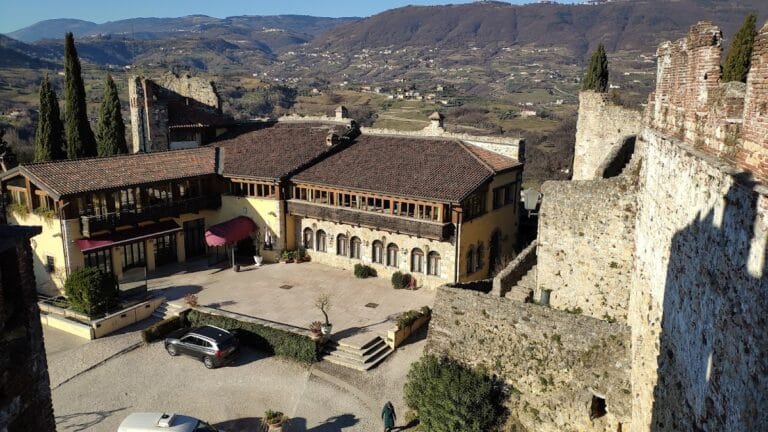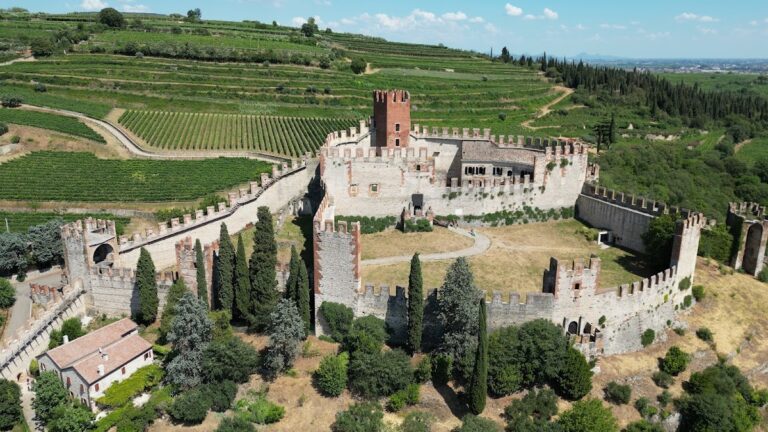Castello Bissari Sforza Colleoni: A Medieval Fortress in Costabissara, Italy
Visitor Information
Google Rating: 4.4
Popularity: Very Low
Google Maps: View on Google Maps
Country: Italy
Civilization: Unclassified
Remains: Military
History
The Castello Bissari Sforza Colleoni is situated in the town of Costabissara in present-day Italy. This medieval fortress was originally constructed by local nobility during the early Middle Ages, with its foundation traced back to the 10th century.
Initially, the castle belonged to the counts Della Costa and formed part of the feudal territory known as Costa Fabrica, which encompassed two other nearby castles, Donna Berta and Pizamerlo. These sites predate the Bissari family’s acquisition and influenced the name of the community of Costabissara itself. In 1241, the castle suffered destruction at the hands of Ezzelino III, a local military leader. Afterward, the fortress was rebuilt and became the possession of the Bissari family in 1285, marking the beginning of a long period of ownership by this noble house.
Following centuries under the Bissari lineage, the last heir to the family, Girolamo Enrico Sforza, died in 1859. Ownership then passed to Count Guardino Colleoni, who undertook significant renovations and expanded the property. His work included landscaping the grounds with a pine grove, vineyard, and orchard, as well as installing a commemorative plaque honoring past proprietors. Later, in 1894, the castle changed hands again when it was purchased by Pia Zabeo and her husband, Marquis Aleduse De Buzzacarini De Vetulis. The couple further enhanced the estate, transforming it into a refined noble villa with added artistic touches.
In the early 20th century, the De Buzzacarini family oversaw the restoration of the small chapel, known as the Oratory of Sant’Antonio, located within the castle grounds. This included the addition of a bell tower, and the chapel was reconsecrated in 1900 by Bishop Antonio Feruglio. Since 1973, the site has been under the care of the Putin family, who initiated restoration works in 1979 to preserve the historical structure.
Remains
The Castello Bissari Sforza Colleoni features a main fortress block comprising the oldest surviving elements, dating back to its medieval origins. This central building retains four original Gothic-style windows and is characterized by particularly thick load-bearing walls, with the northeast corner suggesting the presence of a former tower. During the 11th and 12th centuries, a defensive wall once surrounded the hill’s slope encasing the castle, emphasizing its role as a fortified site.
Alterations over the centuries brought additional architectural features. In the 16th century, two new windows were inserted on the southwest side, accompanied by an entrance door opening from the portico and another internal door aligned opposite it. The 18th century saw the construction of a small balcony on the same southwest facade. However, much of the castle’s present-day medieval appearance arises from the 19th-century renovations undertaken by Count Guardino Colleoni.
Within the castle grounds lies the Oratory of Sant’Antonio, a modest chapel reached by ascending a long staircase from a gated entrance on the adjacent road. The gate bears the coats of arms belonging to Marquis De Buzzacarini and Pia Zabeo, linking the chapel to their tenure. Inside, the walls feature frescoes by Gino Raselli of Asolo, illustrating the miracles attributed to Saint Anthony. A Carrara marble altar stands at the focal point of the chapel, adorned with a statue portraying Saint Anthony addressing worshippers. Embedded in the center of the chapel floor is the tomb of the family, integrating both religious devotion and commemorative function in this sacred space.
The landscaped surroundings reflect the 19th-century enhancements initiated by Count Colleoni, including a pine grove, vineyard, and orchard that complement the castle’s imposing stone structure. Throughout the exterior, plaques commemorate the key historic owners—the Bissari, Sforza, and Colleoni families—highlighting the castle’s layered lineage and its enduring place in local heritage.







